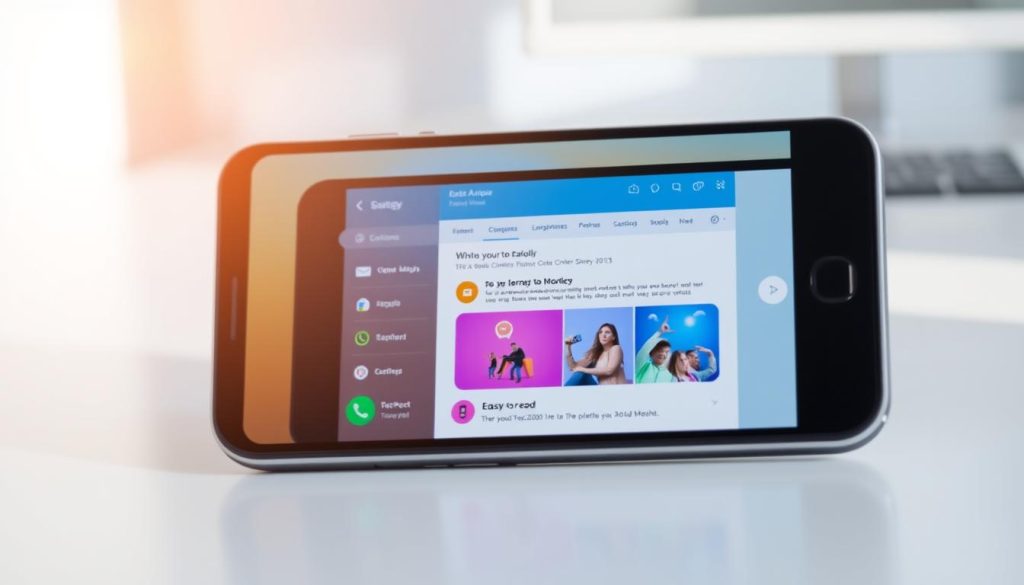In the world of healthcare recruitment, reaching candidates by email is key. But fighting spam filters is tough. As a professional writer, I’ll share tips to help medical staffing pros get past spam filters.
Key Takeaways
- Know what triggers spam filters, like sender reputation and email list quality.
- Write great subject lines that grab attention and are personal.
- Keep your email list clean by focusing on opt-ins and regular cleaning.
- Make your emails easy to deliver by using the right mix of text and images.
- Watch your email metrics and keep testing to improve your emails.
Understand How Spam Filters Work
To make sure your medical staffing emails get to the right people, you need to know how spam filters work. These systems help keep bad emails out but can sometimes block good ones too.
What Triggers Spam Filters?
Spam filters look for signs that a message might be spam. They check for things like:
- Too many capital letters, exclamation points, or words like “free” or “guaranteed”
- Subject lines that look spammy
- Too many images or links
- The sender’s history of sending unwanted emails
Common Spam Filter Algorithms
Email providers use spam filter algorithms to catch spam. Some common methods include:
- Looking at the message’s content, images, and links for spam signs
- Checking if the sender is known and trusted
- Using rules and learning to spot suspicious messages
The Importance of Sender Reputation
Having a good sender reputation is key to avoiding spam filters. Email providers watch how senders act. Those who send good, wanted emails are more likely to get theirs through.
“Keeping a strong sender reputation is crucial for your medical staffing emails to reach your audience.”
By learning about spam filters and working on your sender reputation, you can get your emails delivered better.
Crafting Compelling Subject Lines
The subject line is key in medical staffing emails. It grabs the attention of healthcare pros. Making it engaging and spam-free is a challenge, but it’s crucial for success.
Keep It Short and Relevant
The best subject line length is 30-50 characters. This makes sure it shows up on all devices. It should clearly show what’s in the email and grab interest. Don’t use vague or generic lines that miss the point.
Avoid Spammy Words and Phrases
- Don’t use words like “free,” “limited time offer,” or “urgent” as they’re spammy.
- Too much punctuation, capitalization, or exclamation points can set off spam filters.
- Make your subject lines informative, short, and valuable to the reader.
Personalize Your Subject Lines
Personalization is powerful in healthcare recruitment. Use the recipient’s name, job title, or other details in the subject line. This builds trust and shows your message is for them.
| Subject Line Example | Optimization |
|---|---|
| “Exciting Opportunity for Registered Nurses” | Short, relevant, and avoids spammy language |
| “[Name], Urgent Need for Experienced Nurse Manager” | Personalized and specific to the recipient’s role |
| “Free $1,000 Hiring Bonus for Physicians!” | Triggers spam filters with “free” and excessive punctuation |
Mastering subject line crafting boosts email open rates and engagement. Use personalization, relevance, and avoid spammy words. This is how you succeed in healthcare recruitment.
Building a Clean Email List
In the world of medical staffing, having a clean email list is key. It helps you talk to healthcare professionals better. By using opt-in strategies and cleaning your list often, your messages will get to the right people. And they won’t end up in the spam folder.
Importance of Opt-Ins and Subscriptions
Getting consent from your contacts is the base of a good email list. Focus on opt-in strategies that let healthcare pros choose to get your emails. This makes your messages more likely to get through and builds trust.
Regularly Clean Your Email List
Your email list can get messy over time. It might have old, inactive, or wrong medical professional contacts. Cleaning your list often can make your email marketing better. Get rid of bounced emails, unsubscribes, and those who haven’t opened your emails in a while.
Use Double Opt-In Strategies
- Use a double opt-in process. New subscribers must confirm their email list management subscription by replying to a confirmation email.
- This two-step check makes sure your list is real. It lowers the chance of spam traps or wrong entries.
By focusing on a clean, engaged email list, you can reach healthcare professionals better. This boosts your email marketing efforts.
Optimize Email Content for Deliverability
In the world of healthcare communication, getting your emails to the right people is key. Email content optimization is all about finding the right mix of text and images. It also means avoiding spam trigger words to dodge healthcare communication spam filters.
Maintain a Balanced Text-to-Image Ratio
Creating emails that look good and are easy to read is important. But, don’t make your emails too full of pictures. This can set off spam filters. Try to keep your emails 60% text and 40% images. This way, your message is clear and interesting to look at.
Avoid Trigger Words in Your Content
- Stay away from words like “free,” “limited time,” “act now,” and “buy now.” These words can make spam filters flag your email.
- Write subject lines and email content that are engaging. Show the value of your healthcare staffing services without using too much hype.
- Check your email content often. Look for any spam trigger words that might hurt your email content optimization efforts.
“Deliverability is the foundation of effective email marketing. By optimizing your content and avoiding common pitfalls, you can ensure your healthcare staffing messages reach the right inboxes.”
Personalization and Targeting
In the world of medical staffing, email personalization and audience segmentation are key. They help improve engagement and delivery rates. Let’s look at how to segment your audience and create personalized offers that connect with healthcare professionals.
Segment Your Audience Effectively
Starting with audience segmentation is vital. Gather data on your contacts, like their specialty and location. This lets you send messages that meet their needs and interests.
- Segment by location to show job chances in certain areas.
- Make messages for different roles, like nurses or doctors.
- Personalize content for each specialty or area of expertise.
Use Personalized Greetings and Offers
After segmenting, use personalization to grab attention. Personalized greetings and offers make your emails more relevant and effective.
- Use the recipient’s name in greetings for a personal touch.
- Highlight jobs that match their skills and interests.
- Offer special benefits, like bonuses or flexible hours, to attract them.
By using these email personalization and audience segmentation strategies, you can run effective targeted healthcare recruitment campaigns. These campaigns will engage your audience and drive real results.
Design Email for Readability
Healthcare email marketing needs emails that are easy to read and look good. A well-designed email makes reading fun. It also helps emails get delivered and read more.
Use Simple Layouts and Fonts
Choose layouts that are clean and simple. This lets healthcare pros quickly get the message. Use clear headings, short paragraphs, and lots of white space.
Pick fonts that are easy to read, like Arial or Verdana. Avoid fancy fonts that are hard to read.
Mobile Optimization Matters
Many emails are read on phones now. Make sure your email looks good on phones. Use a layout that changes size, adjust font sizes, and place images and buttons well.
This makes your email easy to read on phones. It gives a good experience to your healthcare audience.
| Best Practices for Improving Healthcare Email Readability |
|---|
|

Follow these email design tips and focus on mobile optimization. Healthcare groups can make emails that grab the attention of medical pros.
Maintain Regular Sending Patterns
In the world of medical staffing, it’s all about keeping in touch. Sending emails regularly helps avoid spam filters. This way, your messages get to the right people.
By sending emails at the same time, you build trust. This helps you connect better with people who might need your services.
Establish an Email Sending Schedule
Being consistent is key to good email outreach. Create a schedule that fits your goals and what your audience likes. Think about:
- The best sending frequency for your field and audience (like weekly or monthly)
- The best times to send emails
- Keeping your email content the same
Sticking to a schedule makes your emails reliable. It helps keep you in mind with your contacts.
Avoid Sudden Spikes in Email Volume
It’s good to keep in touch, but don’t send too many emails at once. Big email sends can look spammy. This might make your emails get flagged.
Instead, send emails a little at a time. Or split your list into smaller groups. This keeps your emails steady and safe from spam filters.
By following these tips, you’ll send emails that get through better. This leads to stronger connections with your audience. And that’s good for your medical staffing business.
| Metric | Recommended Range | Explanation |
|---|---|---|
| Email Sending Frequency | 1-4 times per month | Sending too many emails can overwhelm people. Keep your sending regular to find the right balance. |
| Email Volume Spikes | Less than 20% increase | Big email sends can look spammy. Keep your volume increases under 20% to stay spam-free. |
Monitor Engagement Metrics
As a healthcare recruitment pro, it’s key to track email engagement metrics. This helps your medical staffing campaigns succeed. By watching open rates and click-through rates, you learn a lot. This knowledge helps you improve your email outreach.
Track Open and Click Rates
First, keep an eye on your email open rates and click-through rates. These email analytics show how well your messages are doing. A high open rate means your subject lines are good. A strong click-through rate shows people are really interested.
Adjust Strategies Based on Engagement
- Look at the engagement metrics to find patterns and trends in your work.
- Use what you learn to make your email content better. This includes subject lines and who you send it to.
- Keep trying new things and use the data to make your email marketing even better.
By watching and acting on your email metrics, you can do better. This helps you reach more healthcare pros who are a good fit.
Test and Analyze Your Emails
Creating great medical staffing emails is a never-ending task. The secret to getting better is testing and analyzing your emails. Use A/B testing and watch your email performance to make your messages better. This way, you’ll reach the right people and get the results you want.
Conduct A/B Testing for Subject Lines
The subject line is key to getting your email opened. A/B testing your subject lines shows what works best. Try different lengths, tones, and personal touches. See which ones get more opens to find your best subject line.
Analyze Spam Complaint Rates
Keeping an eye on spam complaints is vital. High rates can hurt your email delivery. Look at your spam data to spot problems. Then, change your emails to avoid spam filters.
Using A/B testing and watching your email metrics, like spam complaint monitoring, helps a lot. This way, you can make your emails better. You’ll get more people to open and read your emails, improving your success.
Continually Educate Your Team
Keeping your team well-informed is key to your email marketing success. They need to know the latest in email marketing and healthcare trends. This knowledge helps them send messages that really connect with your audience.
Importance of Staying Updated on Email Best Practices
Email marketing is always changing. New rules and strategies pop up all the time. Make sure your team stays current with these updates. Talk about how to keep emails delivered and how to make them better.
Share Insights from Email Marketing Trends
Knowing the latest in healthcare email trends is super helpful. Share what works in subject lines and content. Encourage your team to try new things and keep improving based on what they learn.






